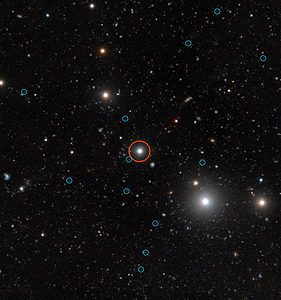An international team of astronomers may have come across the first sound evidence testifying the existence of dark galaxies – cosmic bodies from the early Universe long theorized by scientists in the past, but never before confirmed until now.
Dark galaxies are small, gas-rich galaxies that are very inefficient at forming stars themselves. Their name comes from the fact that they’re void of stars, thus no light is emitted, making them theoretically invisible. Scientists consider dark galaxies to have played a major role in star-rich galaxy formation during the early Universe expansion, feeding neighboring galaxies with precious gas required to birth stars.
Since dark galaxies don’t emit any light, confirming their existence has been always extremely difficult for scientists attempting such a feat. Previous studies of small absorption dips in the spectra of background light sources were thought to have hinted at dark galaxies, but this newly presented research is the first to provide rather tantalizing proof.
Using the European Southern Observatory’s Very Large Telescope (VLT) in northern Chile, the researchers saw the extremely faint fluorescent glow of the dark galaxies.
“Our approach to the problem of detecting a dark galaxy was simply to shine a bright light on it,” says Simon Lilly of ETH Zurich.
“We searched for the fluorescent glow of the gas in dark galaxies when they are illuminated by the ultraviolet light from a nearby and very bright quasar. The light from the quasar makes the dark galaxies light up in a process similar to how white clothes are illuminated by ultraviolet lamps in a night club.”

The telescope was directed towards a patch of the sky, around the bright quasar HE 0109-3518, where it mapped the region and looked for ultraviolet light released by hydrogen gas when subjected to radiation. Quasars are the brightest and most energetic objects in the Universe. The exposure time was enormous, but in the end it paid out for the astronomers.
“After several years of attempts to detect fluorescent emission from dark galaxies, our results demonstrate the potential of our method to discover and study these fascinating and previously invisible objects,” study lead author Sebastiano Cantalupo, from the University of California, Santa Cruz, said in a statement.
Their initial round of data returned 100 possible gaseous objects which lie within a few million light-years of the quasar. Eliminating objects where the emission might have been powered by internal star-formation in neighborliness galaxies, the team of researchers narrowed the list down to 12.
Also, the researchers were able to determine some of the dark galaxies’ properties. They speculate the mass of the gas in dark galaxies is about one billion times that of the sun, and that they’re 100 times less efficient at forming stars than most galaxies of the time. Their exact composition hasn’t been determined yet, since there’s no conclusive way of determining it. However, theoretically they’re composed of hydrogen, dust and dark matter.
“Our observations with the VLT have provided evidence for the existence of compact and isolated dark clouds,” Cantalupo said. “With this study, we’ve made a crucial step towards revealing and understanding the obscure early stages of galaxy formation and how galaxies acquired their gas.”
This research was presented in a paper entitled “Detection of dark galaxies and circum-galactic filaments fluorescently illuminated by a quasar at z=2.4”, by Cantalupo et al. to appear in Monthly Notices of the Royal Astronomical Society.
source: ESO


